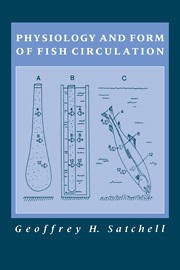Book contents
- Frontmatter
- Contents
- Preface
- 1 Introduction
- 2 The Heart
- 3 The peripheral circulation
- 4 The blood
- 5 Haemopoiesis and phagocytosis - the mononuclear phagocytic system
- 6 Circulation through special regions
- 7 Retial counter-current systems: flow–diffusion–concentration
- 8 Venous return and venous pumps
- 9 The autonomic nervous system
- 10 The response to exercise
- 11 The response to hypoxia
- 12 Myxine, a speculative conclusion
- References
- Appendix of popular and scientific names
- Index
6 - Circulation through special regions
Published online by Cambridge University Press: 05 February 2012
- Frontmatter
- Contents
- Preface
- 1 Introduction
- 2 The Heart
- 3 The peripheral circulation
- 4 The blood
- 5 Haemopoiesis and phagocytosis - the mononuclear phagocytic system
- 6 Circulation through special regions
- 7 Retial counter-current systems: flow–diffusion–concentration
- 8 Venous return and venous pumps
- 9 The autonomic nervous system
- 10 The response to exercise
- 11 The response to hypoxia
- 12 Myxine, a speculative conclusion
- References
- Appendix of popular and scientific names
- Index
Summary
The microcirculation of the gill
Introduction
The gill of a fish is a multifunction organ. Across its epithelium occurs an exchange of the respiratory gases and in most fish it is the major if not the sole organ of gas exchange. It is also a major site of water ingress and egress, by osmosis. It is significantly involved in ionic regulation, and in acid–base balance. It is an important site of nitrogen excretion. Toxicants ingested with the food may be cleared through the gills; Nakatani (1966) reports that most of the zinc ingested by trout is lost through the gills and Matthiessen and Brafield (1977) suggest that this occurs through the activity of the chloride cells. There is now evidence that the microcirculation of the gill is specialized in connection with some of these functions. Although there are differences between species, three separate circulatory pathways can be recognized in the fish gill.
On each side of the pharynx of a teleost are four gill arches, each bearing a double row of gill filaments; the tips of the filaments of adjacent arches touch, so that water has to flow between adjacent filaments. Each bears, on its upper and lower surfaces, a row of closely spaced leaflets, the secondary lamellae. A secondary lamella can be likened to an envelope. Its two parallel faces are spaced apart and anchored by pillar cells which prevent it from ballooning out in response to the pressure of the blood within. The lamellar wall consists of two layers; the outer epithelial layer may be one or two cells thick and is supported by a strong basement membrane.
- Type
- Chapter
- Information
- Physiology and Form of Fish Circulation , pp. 89 - 105Publisher: Cambridge University PressPrint publication year: 1991



